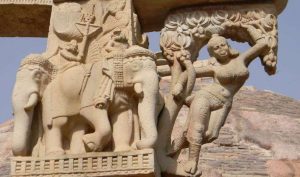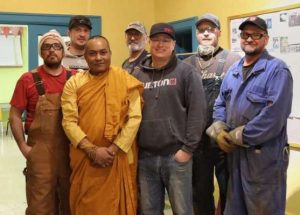Professor Birgit Kellner was the keynote speaker at the two-day Unlocking Buddhist Heritage conference at the British Library in London in February. Since 2015, Prof. Kellner has served as director at the Institute for the Cultural and Intellectual History of Asia of the Austrian Academy of Sciences in Vienna. She is an adjunct professor at the University of Heidelberg, a corresponding member of the Austrian Academy of Sciences, a fellow of the Alexander von Humboldt Foundation, and a vice president of the International Association of Buddhist Studies. Her speech for the conference was titled: “Worshipped as Precious Relics? On the Valuation of Indian Manuscripts in the History of Tibetan Buddhism.”
Buddhistdoor Global: Can you share with our readers who were unable attend the conference a little about your keynote address, and why you thought the subject was important?
Birgit Kellner: I am interested in a very large class of Indian Buddhist manuscripts—thousands of texts—that were preserved in Tibet. Most of them were brought between the 11th and 14th centuries, but they survived in large numbers and still exist today. Since Indian Buddhist literature in India was very badly preserved, these manuscripts offer really unique insights into the literature and the history of Indian Buddhism. This is why we tend to approach these texts as witnesses or windows on Indian Buddhism. However, I also look at how these manuscripts and texts were approached in the history of Tibetan Buddhism by various Tibetan actors. So I am more interested in them as cultural objects in Tibet, in the Tibetan context. This is a line of inquiry that has only recently begun and we are not at a stage where we can paint something like a continuous historical narrative. So what I was trying to do was simply to present two very different historical settings. The first concerns the period spanning between the 10th and 14th centuries when these manuscripts were very actively circulating: they were used in teaching, in translation contexts, and thus collections started to form.
Because the conference focused on the subject of connection, I tried to think about how monastic collections of manuscripts in this particular period came about, how Indian manuscripts were conceptualized in the context of these collections, and what role they covered.
The second context that I spoke about was the period spanning between the late 19th and early 20th centuries. This was when Western scholars and also one particular Japanese monk—Ekai Kawaguchi—became interested in Tibetan texts in general, but also in Sanskrit manuscripts in Tibet. They began by recording all the information they could gather, and from the 1930s they also gained access to Tibetan monasteries and were able to photograph all these manuscripts.
This is basically what I was trying to do in this keynote, and I smuggled in various bits and pieces and interesting observations about individual instances that give us a glimpse of how Indian manuscripts in Tibet were perceived, how they were treated, how they were approached, how they were passed on, and also, once Indian masters died in Tibet, what happened to these manuscripts that were left behind.

BDG: Who were some of the key historical players in cementing the extremely prestigious role of Indian manuscripts in Tibetan Buddhism?
BK: This is very hard to say in detail. As I just said, we do not really have a historical survey of that, but I also think—and this applies perhaps to many of the contexts in discussion at this conference—that you can’t really separate manuscripts as material objects from the texts that they transmit. So in order to answer this question you would also have to ask: who were the key historical players in cementing the prestigious role of Indian texts, i.e. of Indian sources, in Tibetan Buddhism? This is just a very wide-ranging phenomenon, if one considers the breadth of the dissemination of Indian Buddhism to Tibet. This is phenomenon on a massive scale; you would have to enumerate hundreds of Indian masters. This is not a question that is easy to answer.
BDG: In your experience, what are some current dominant “paradigms” or trends of research into Indo-Tibetan Buddhism, or research into the links between Tibetan and Indian Buddhism?
BK: I think that this is a very interesting question because the whole label of “Indo-Tibetan Buddhism” has come into criticism. There are people who have argued that this denomination represents a position where Tibetan Buddhism is thought of as an authentic representation or storehouse of Indian Buddhism. It was argued that this in itself is actually an ideology that has been perpetuated by certain traditions within Tibet, that is to say: certain Tibetan Buddhist traditions would like to see themselves—and have also historically presented themselves—as the repository of “authentic Indian Buddhism,” especially in interactions with the Chinese. Thus this label has been called into question. At the same time, some people have started to look more specifically at how India, as a cultural marker, and Indian tradition come up in individual and distinct historical contexts such as art history, for instance, or doctrinal polemics, thus offering different sides of inquiry. What I would like to see as a trend or becoming a trend is precisely that historicization that moves away from a perspective in which Tibetan Buddhism is just a passive recipient of Indian learning and knowledge to a perspective where you have a more nuanced picture.
For example, one of my colleagues, Markus Viehbeck, has studied how in 19th century doctrinal polemics—that are conducted completely in Tibetan and that are far removed from the actual contact of living Indian Buddhism, which had already died out—you still find people quoting predominantly Indian sources in translation. I think this is significant. The fact that these texts do not quote Tsongkhapa, for instance, or Tibetan masters from the 15th century, means that they still feel the need to invoke Indian authority. This is something significant and I would like to see more studies of this kind that tease out Indian elements in Tibetan Buddhist history.
BDG: What research projects are you currently working on?
BK: A project that I have just started is called “Rationality, Meditation, and Liberation in Indian Buddhism.” It is a very broad title. More specifically we are looking at the late eighth century author Kamalaśīla, who is very well known as a philosopher and also because of his participation in the controversy with Chan Buddhists in Tibet. In this project we mainly analyze the sūtra commentaries that Kamalaśīla wrote. He composed an extensive commentary on the Vajracchedikā and also a very interesting commentary on a short Yogācāra-inspired sūtra, called the Nirvikalpapraveśadhāraṇī (‘phags pa rnam par mi rtog par ‘jug pa’i gzungs kyi rgya cher ‘grel pa). These are doctrinally very different: the Vajracchedikā is a Prajñāpāramitā text, the Nirvikalpapraveśadhāraṇī is a more Yogācāra text, and Kamalaśīla interprets these texts from a Mādhyamika perspective.
At the moment we are preparing the groundwork. One post-doctoral and one doctoral student are involved in editing these texts and translating them; that constitutes the solid groundwork. But then we also try to contextualize them within the context of Kamalaśīla’s philosophical work. I think this is a really interesting and somewhat unexplored topic. We look at philosophers who also were engaged in sūtra commentaries and we question why they actually feel it necessary to comment on these sūtras at that particular point in time. But we also investigate the nature of these commentaries, and try to map this whole terrain of sūtra commentaries in late medieval Indian Buddhism in general.
BDG: Did you go see the British Library exhibition? What did you think of it?
BK: It was very interesting. I especially liked the didactic aspect of it, like showing palm leaves, mulberry paper, and letting you touch these different kinds of paper. It is quite something when you are able to feel a palm leaf manuscript for the first time. I had never touched a palm leaf manuscript before. I think the BL holds many more riches obviously than those that were able to display. I felt that the special focus on recent Southeast Asian material, that was coming from the curator’s own perspective, might have been a little over represented.
BDG: Prof. Kellner, thank you very much!











